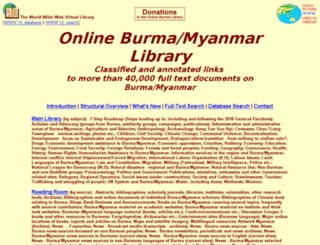Focal point
Location
The Online Burma/Myanmar Library (OBL) is a non-profit online research library mainly in English and Burmese serving academics, activists, diplomats, NGOs, CSOs, CBOs and other Burmese and international actors. It is also, of course, open to the general public. Though we provide lists of Burma/Myanmar news sources, the Library’s main content is not news but in-depth articles, reports, laws, videos and links to other websites, We provide a search engine (database and full text) and an alphabetical list of categories and sub-categories, but the Library is best accessed through browsing the 100 or so categories which lead to sub- and sub-sub categories. These tools should be used in combination.
Members:
Resources
Displaying 856 - 860 of 1151Flight, Hunger and Survival: Repression and Displacement in the Villages of Papun and Nyaunglebin Districts
This report documents in detail the plight of villagers and the internally displaced in these two
northern Karen regions. Since 1997 the SPDC has destroyed or relocated over 200 villages here,
forcing tens of thousands of villagers to flee into hiding in the hills where they are now being
hunted down and shot on sight by close to 50 SPDC Army battalions. The troops are now
systematically destroying crops, food supplies and farmfields to flush the villagers out of the hills,
Burma Human Rights Yearbook 2000: The Situation of Refugees
There are currently more than 120,000 refugees living in Thailand. Refugees from Burma are also in refugee camps along the
Bangladeshi and Indian borders as well as working and living in Bangladesh, India, Pakistan and Malaysia. The line between
refugee and migrant is a thin one and there are also an estimated 1 million migrant workers living in Thailand who have fled from
their homes for many of the same reasons that official refugees have. (The topic of migrant workers from Burma is covered in
Landmine chapter of the Burma Human Rights Yearbook 2000
Landmines are weapons that kill and maim indiscriminately, whether it be civilians, soldiers, elderly, women, children or animals
and cause injury and death long after the official end of a war. Contrary to trends in the rest of the world, rather than reduce or
abolish the use of landmines, the SPDC has actually increased production of anti-personnel landmines and at least in the case of
the Burma-Bangladesh border, is actively maintaining minefields. In Asia, Burma is currently second only to Afghanistan in the
Burma Human Rights Yearbook 2000: Internally Displaced People and Forced Relocation
The plight of Internally Displaced People, or IDPs, in Burma was a continuing problem over the year 2000. Burma contributes
over an estimated 1 million IDPs to the estimated world IDP population of 21 million and estimated Asian IDP population of 5
million. (The CIDKP put the IDP number at 2 million in 2000.) Internally displaced persons in Burma live under conditions of
severe deprivation and hardship. All but few of these people are without adequate access to food or basic social, health and
Burma Human Rights Yearbook 2000: The Situation of Migrant Workers from Burma
The one million Burmese migrant workers in Thailand are one of the largest migrant populations in Asia. Migrant workers from Burma come from a variety of geographical locations and ethnic groups and work in several different industries and service sectors in Thailand. There are both push and pull factors at work when people make the decision to migrate to Thailand. The pull factors include the close geographical location of Thailand to Burma as well as the demand in Thailand for cheap labor.


